Starfield
2023, PC (Windows/ Steam)

Disclaimer: This is a long post, including rants from someone who has played Bethesda games since Morrowind (2001). As for spoilers, if you have not played a Bethesda game before, now is the time to walk away. If you are a returning player, there cannot be anything to spoil your experience; you have seen it all.
Bethesda (noun): A hyped game company, which publishes modding platforms masking as video games, the latter form to be arrived at by modders without being on the company’s payroll. Usually the company then sells the improved game as Game of the Year or Anniversary Editions.
Usage: Nexus Mods website is again getting exponentially large traffic, because of a new Bethesda game.
Bethesda (adjective): Average. Below par but cannot be dismissed. A celebration in mediocrity.
Usage: Starfield is a Bethesda game. It got a rating of Bethesda out of 10.
Who would like Starfield?
- Those who have not played any Bethesda game ever, and have a top of the line PC to brute-force through un-optimized games, or are content with 30 fps.
- Those who got to play the over-hyped game on day 1 with a $10 game pass, or AMD Starfield Bundle, the hype making them feel special and superior to other platforms’ players who either have to buy at full price or wait.
- Oldies who have played too much of Bethesda games, from Morrowind/ Fallout 3 or earlier, know exactly what the skill set of Todd Howard is, and do not expect him to surpass himself with a Mass Effect.





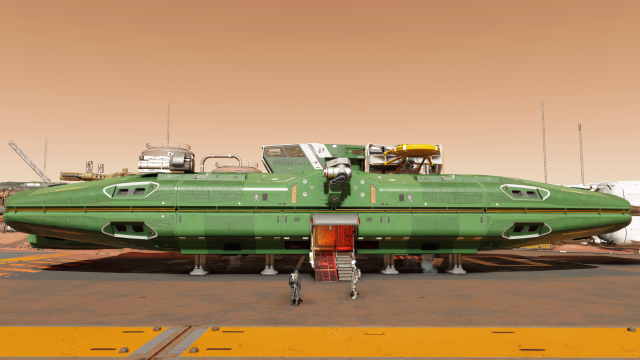



Who wouldn’t like Starfield?
- Those who stepped out of their basement since Fallout 4, are aware that the gaming industry have evolved, and have played other games that do almost everything Starfield does but better.
- People with above-average hardware who can run Cyberpunk 2077 Phantom Liberty at 1440p 60 fps locked but cannot reach 60 fps on Starfield even at 1080p, when latter’s visual fidelity is at Fallout 4 (2015)’s HD texture levels.
- Oldies who have played too much of Bethesda games, from Morrowind/ Fallout 3 or earlier, and badly wanted Todd to deliver on his claim of a “new IP in 25 years”.
A grounded million-cred spaceship
The opening sequence in the mines has a rock solid 1080p 60 fps on my Ryzen 4500 and GTX 1070 Ti (minimum PC requirements). Although the area is walled, there were still enough lights and shadows to tax the video card if at all the rendering design demanded. The game does not have ray tracing, but something called Real Time Global Illumination, which is an alternative to RT without tensor cores (it is AMD sponsored title). But the fidelity is way inferior by 2023 standards. Few moments later, when I was about to exit the miners’ quarters, that area too was walled but I could only get 45 fps with everything at low, even at 50% resolution scaling of 1080p (i.e. 540p)! Given the quality of image, extra lights and reflections in the living quarters compared to the mine below should not have reduced the frame rate by 25%.
Recent games with way better rasterized fidelity and similar map design are Cyberpunk 2077, Ghost Recon: Breakpoint, Ghostwire: Tokyo, and Doom Eternal (latter two also Bethesda-published). Even if some of these games barely crawled at launch, in Starfield the issue is more apparent because visual fidelity is vastly inferior. It seems to be some additional constraint to optimize for 30 fps, which impacts someone playing at 60, similar to running emulated games which are designed for 30 fps. The above titles have improved a lot with patches, but it is less likely for Bethesda to update the game for performance without trying to sell another “Special” or “Anniversary” edition. Only future can tell if it is otherwise, when their benevolent Dear Leader has already “advised” customers to upgrade their PC.
For perspective, GhostWire: Tokyo (2022) runs at 1440p 60 fps on the same above hardware with FSR Quality. Far Cry 5 runs at 1440 60 fps without any upscaling – as we can see in the screenshots below and the linked post, outdoor grassy environments in Starfield are not better than Far Cry 5. And Ghost Recon: Breakpoint (2021 edition) has been a rock solid 60 fps 1440p (though with Vulkan and FSR 1.0, on my other PC running i5 10600k, the “recommended” CPU for Starfield). Bethesda not just has the excellently competent ID Software team in-house, who have always published well-optimized PC games, but is also now a Microsoft company with access to better resources. Whether it is Halo Infinite running 1440p 60 fps on the Series S, or Doom Eternal on Steam Deck, it is shocking to see a Microsoft published game faring so poorly in terms of max frame rate, not just on PC but on their consoles as well. The Series X, otherwise sold as a 4k/ 120 fps console 3 years back, with TV manufacturers scrambling to advertise “Next-Gen Consoles Ready” if they support those two specs, is capped at 30 fps for Starfield, forget about 60!
The pause menu consumes too much of GPU power, even when it is just rendering the player character holding a weapon. Everything else on the screen are static. Every other menu screen, including the star menu that shows planets of a star system, consumes much less power. The texture quality is very good, like Fallout 4 HD textures. That is why even a 60% resolution scaling at 1080p on a 27″ monitor does not look too blurry. The game should have had texture downscaling based on the graphics presets.
Lack of optimization is apparent when it doesn’t improve GPU performance going from medium to low. The best way to see this is to cap the game at 30 fps and try reducing the resolution scale. Anyone with a PC playing games for like 5 years at least, would know that this should reduce GPU usage. But here it does not – it stays the same at 95-99%, so does the temperatures similar to when the GPU is used at half-capacity (irrespective of the high usage numbers), but the only thing that changes is the wattage. It is as if the game is trying to mine crypto in the background, which fills up whatever cycles are free if we reduce the resolution. So the total usage does not change, but power changes with rendering workload.
Oldies who played original Skyrim (2011) may recall couple of ini tweaks like uGridsToLoad, uExteriorCellBuffer etc. I suspect the game in the name of being “modern” is trying to load more areas than necessary, and distant objects/ lighting at full resolution instead of lower, even if they are not in view, as is the case with frame rates when we are inside the spaceship docked at New Atlantis. Certain things are new in the engine, like if we go to a planet with a nearby moon looming up, the light from the moon brightens the shadows realistically. Draw distance also has improved, with negligible texture pop-in as we run towards the horizon on an empty planet. However, from the context of rendering engine this is just another large point source of light, so there is no excuse for the bad performance in the name of this, unless Bethesda really conspired with hardware companies to make old PC components obsolete, so that they are forced to buy new ones (thankfully Starfield as a game is not good enough to warrant unplanned PC upgrades, more on that below).

On my 10600k and RX 6700 XT, and a 4k TV, it was smooth 60 fps at 40% resolution scaling (i.e. 864p), with a combination of high/ medium/ low, even on New Atlantis or Akila City almost always, except in some places where even if nothing happens on the screen, it is stuck at 57 fps, like in front of HopeTech office. This further cements the point based on these two vastly different hardware configurations, that the game is really a case of bad optimizations and not inadequate hardware.
There are reports of the game trying to execute some bubble code which can be ignored by AMD drivers but not NVIDIA, resulting in massive difference in performance between NVIDIA and AMD GPUs. The community made DLSS mods do help with RTX cards, but GTX cards are left out until NVIDIA can fix this bubble code so that the game can use DX12 efficiently, since the engine is essentially a DX11 one*. New patches post 1.8.86 implements NVIDIA DLSS, and have also improved performance on non-RTX cards that don’t support DLSS, like my GTX 1070 Ti. It is still not a smooth experience given the visual fidelity though.
*Latest FSR3 mod does seem to alleviate performance issues in a GTX 10 series, with my 1070 Ti running at 60 fps locked and 67% of resolution scaling at 1080p. The only issue for now is the ghosting of UI elements, which is a FSR3 issue, to be solved in the coming months hopefully.
For what it is worth, performance on AMD though better, is not without its flaws. Like the 6700 XT should be more than capable of rendering locked 60 fps everywhere at 1080p (50% scaling of 4k), but I had to reduce scaling further through ini file to 40%, to achieve the locked framerate. On top of that, recent patches (v1.8 onward) seem to have tanked performance a bit on AMD GPU, until the Dec 2023 Adrenalin drivers that again improved performance. It is a cat and mouse game because the game itself is not optimized.
Meira, the Cyber Runner
The character screen could not open an on-screen keyboard to enter player name while using a controller. This feature is available in Windows 10/11, and it obviously is there on XBOX consoles or Steam Deck. This is probably why the game has “Partial Controller Support” on Steam, everything else works fine. To their credit, this game seems to have the best controller support yet in a Bethesda game. Auto aim is pretty good, and shooting feels great. Gunplay is probably the biggest plus point of this game. Another good implementation is the photo mode, though it seems to not include the prevalent weather always.




While character creation and UI has been improved over Fallout 4, the actual options seem to be half-thought or just left half-done. Most character presets look the same, with only the hairstyle being different on the same character, with a variance in makeup or skin color. We can select one preset then change the hairstyle to match another preset! I could not find much “male” or “female” options while selecting the hairstyles or jewellery. It seemed that even with 40 odd options, all were designed asexual. So even if you select a male or female walking posture/ body type, the final character cannot be made convincingly binary, only somewhere in between. Quality of character creation and in-game characters are at Indie standards (without prejudice to some of Indie devs who make really extensive games).
This design creeped into few NPCs as well, largely breaking immersion. A character named Vladimir does not look or talk Russian or Eastern European at all. A character named Matteo Khatri (Italian Indian) does not look the part. Another character Saburo Okadugbo, a Japanese + Nigerian name, almost sounds like generated by a Monte Carlo simulation. If you take up a trait that gives you parents to interact with, you look nothing like them. For perspective, Mass Effect Andromeda (2017) had a feature where Senior Ryder could be AI-generated from the playable Ryder character that you created.

All companions are holier-than-thou averagists, without any bias towards or against anything, the quintessential Orwellian universe where everybody’s mind is an echo chamber. One may argue that like planets, perhaps the characters are also AI-generated. These design choices do not make the game inclusive because they were done for the sake of it, just like anything done for the sake of it is always far from it. All they do is break immersion, and it feels as if the publishers wanted to appease some Nazi-like dictators who wanted these stuff by hook or crook without any quality control.
Character traits are interesting, and give a few “what if” moments while selecting. However, the religious options could have been avoided, because up to that point we are not given any introduction about them, so we really don’t know what to expect. They could have enabled them only in New Game+ mode. To be fair, this is a nitpick with some other RPGs too, overwhelming the player with traits before giving them an opportunity to learn about.

One major departure from Bethesda games is that Starfield does not allow taking clothes off killed NPCs. This was fun and immersive; it would allow to easily identify which bodies have been looted, without hovering above them. Here, while you may sometimes get to loot the apparel or armor as if they are carrying two sets – one worn and one in their pocket, it does not remove the one they are wearing. There is no justification to not have it since the game engine has supported it for a long time, unless it was a conscious decision to not show so much skin, for better ESG ratings or so. In that case they should have done away with bikinis too, but they did not. Or at least fix the bug where city guards patrol in their underwear with a gun, just like old times!
Another omission that adds to the suspicion of the game trying to be “woke” is the lack of gore. Gone is the Bethesda Softworks who smashed the brain of an enemy shot at gunpoint with V.A.T.S. Now you get a red paste sprinkled around a body that looks much like the red powder mixed with water during Holi in India. It is not that there are no bloody places. At least one outpost I have encountered that was overrun by arachnids had completely bloody living quarters, so if they wanted to reduce gore, it doesn’t make sense. Or instead of deliberately being woke, perhaps it was a conscious decision to reduce testing effort on a few features of the game engine.



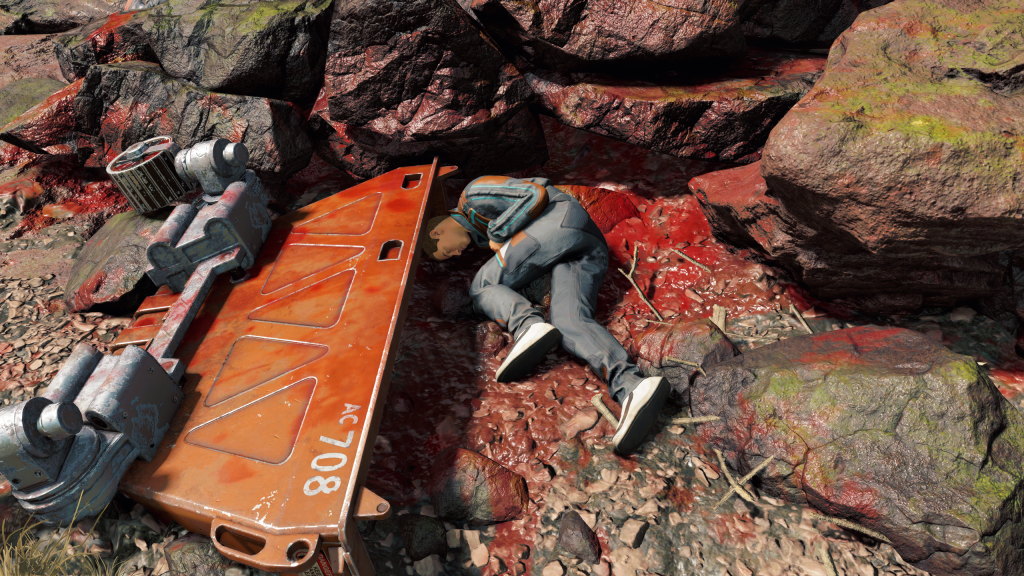
Orbit of Triton, Sol year 2330.
My next mission needed me to board a ship in the orbit of one of Neptune’s satellites. On selecting the location, I fast-traveled to about 6000 units from that ship. I thought, I now need to cover this distance piloting my ship. My ship covered about 25 units in 10-15 secs every time I engaged the thrusters. That means I would need about an hour to reach the destination with same Triton view before me. Funny thing is, I selected a landing area on Triton instead and fast traveled there, then on re-launching into orbit, I immediately found myself within docking distance of the target ship. So the game discourages you from traveling in space, even if for a few thousand kms. Everything is “fast travel”.
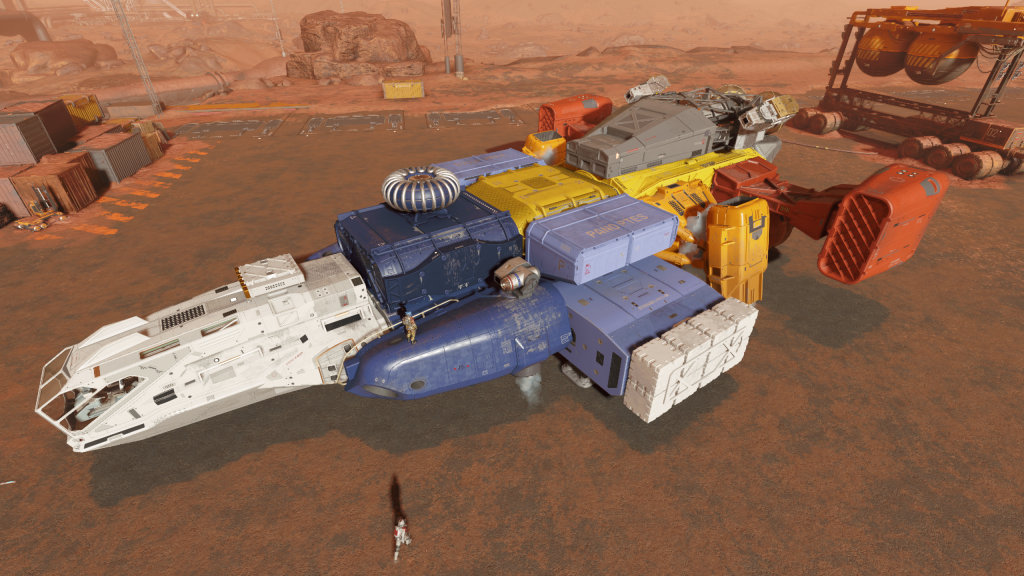
Take-off and landing is done through animations at best. You cannot fly in or out of an exact area. There is an animation of FTL when using “Grav Jumps” between star systems, which is at most a poor copy of No Man’s Sky and does not even attempt to challenge Mass Relays of Mass Effect. One cannot even fly manually across the same planet to different locations. Mostly space travel is just a loading screen. In Mass Effect, the “effect” activating the mass relays then the ship appearing out of nowhere, still gives goosebumps. But that is way above Bethesda’s competency.
The only thing good about this is that you get to bypass poor framerates if you select a destination on planet and travel directly, like The Lodge that bypasses New Atlantis’s horrible frame rates and puts you just before the house.
Ship building is a good implementation, offering tens of hours of creativity, though the controls can be fuzzy with a keyboard compared to a controller (I played the game only with a controller). The best part about it is charging only for the delta amount when a part is replaced – though the buy-back price is much less. Performance issues plague the screen, with frame rates dropping to 30’s even on the 6700 XT, if we simply scroll through the different colors. Nonetheless, exploring with a ship that one has built custom, even if that customization is just new paint, can be immersive at times.


Orbit of Kreet, Sol year 2330.
I met some pirates firing at me. The so called “new IP in 25 years” gave me a V.A.T.S. like combat system when viewed from within a power-armor in Fallout 4. Even the dialogue box font color became yellow from otherwise white, exactly like the HUD of power armor. The only difference was the power armor would walk or run and aiming was more precise, whereas the ship would sail and aiming was intentionally fuzzy.
The ship piloting mechanics are good though. There is a simple, non-distracting system of allocating energy to multiple components, so when fighting, allocate everything to ship weapons, and when traveling, allocate to thrusters and Grav Core. It is non-immersive though, since you “fast travel” instead of seeing it in action. You can also just press a button to “heal” the entire ship without any complications, unlike limb based damage in Fallout where one could see which part got healed.


Allocating additional points in Grav Core do not seem to do much; one point is enough to initiate a jump. There are limits in grav jump, only because it is tied to a skill. There is no fuel consumption concept, which should have been a natural corollary. As long as two star systems are within the ship’s range, a grav jump will instantly take you to one from the other for free (um, a fast travel screen is the price you pay). Even if the game shows fuel consumption during that jump, it does not actually require one to refuel after. The good part is that you don’t need to bother about inter-star-system travel except adding skills to grav jumps and upgrading the ship. The bad part is right at level 1 you could fly from one system to the next without having to make any payment which is not immersive for a space RPG.
Exploring the Constellation, Sol year 2330.
New Atlantis, the most advertised location in the game, failed to make a first impression on me, because Mass Effect from 2007 did far better job in designing space colonies. Even Ghost Recon: Breakpoint’s Skell Tech offices and residences were more futuristic compared to this. New Atlantis looks like any modern International Airport. Perhaps Todd dreamt too much of them while constrained to his home during the lockdown.

I reached Mars within few hours of starting the odyssey. Wandering about in the planet led me to some location markers in the distance. Explorers among us would have found it very exciting, only if planetary exploration was not shafted so badly as well. All the places look the same, and running for a few mins won’t get you anywhere special. One good improvement over Fallout 4 is vastly reduced texture pop-in, and the game consumes less VRAM for the resolution compared to other games, though lately with patch 1.8.86+ it seems to have increased a bit (like it now consumes about 9 GB of the 6700 XT).
Did Bethesda not have any QA on quality of life stuff when testing the product?
There are “Geological Formations” to be explored. A sum total of 3 different types could be encountered in almost 100 hours of play across 3 different save-game profiles, each following as much independent path and quests as possible. There is a mission to identify a planet in a system with “Coralline Landmass”, a form of algae. None of the planets or moons in the system would have it. Ultimately it was found in a ice-cold moon which showed “no flora” on the scanner!


This is a shame, because most video game players can appreciate science. It is definitely a pattern if you like solving puzzles in a computer generated (here though, just duplicated) world by yourself, when others might be happy with a movie or a novel. Not to generalize though, since a “gamer” can also enjoy those. The point is that lack of scientific basis for stuff happening in video games are harder to digest, compared to a fictitious novel or movie. Like, we still have recoil in guns right? And ammo magazines do empty and need to be reloaded? Grenade explosions have impact only in a sphere of certain radius? Etc.


Other examples of unscientific nonsense are aplenty. If a planet has 1/6th gravity, why would we still use up oxygen in the same rate as in a planet with 1G? Conversely, a planet with 1.5G should tire the player sooner, or reduce the encumbrance limit accordingly. Why would your oxygen levels reduce on a planet “with” oxygen (like Earth’s equivalent planets) if you run over-encumbered? Sure, your running speed can reduce (like you cannot fast travel or run), your health can reduce at a low rate over time, but can you ever run out of oxygen on that planet?

Why frag grenades/ fire canisters work or any kind of fire can be set on planets without any atmosphere? Can fire burn without it? Why does an outpost have rust when there is no atmosphere or even water on that moon? That same outpost also gives you a mission to rescue a partner from a cave, who was stuck due to storm (no atmosphere)! And perhaps that cave will have tree roots sprouting in some corners as well! Tree leaves in New Atlantis are so strong that you can stand on them. Pete Hines, the top guy of Zenimax, surely will defend it by saying “it is by design” – as a dedicated salesman covering for ineptness of his team. It is us who have to play through the ordeal after buying the game, not him.
The game is so shallow that few, insignificant number of nominal scientific expectations about space and physics would be met if at all.
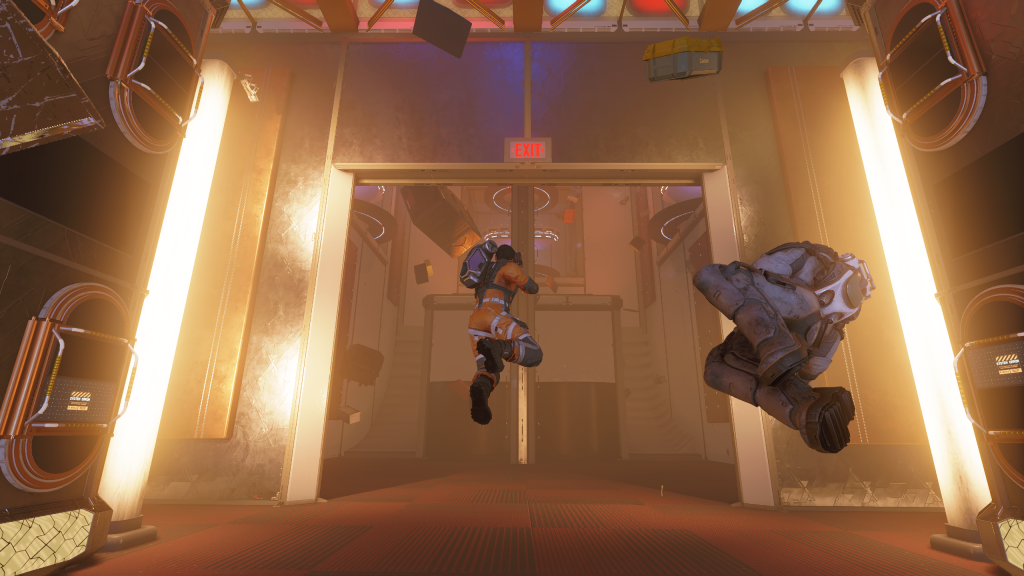
Having said that, there is zero-G, and it is actually fun. A space casino or the temples for obtaining dragon shouts (um, powers) are well-designed where you just float without gravity, one of the highlights of world design. However, the lack of scientific oversight is evident when you can “boost” up or down even without a boostpack in a zero-G environment. Other good things are combat mechanics and gunplay, especially the “new” animation when someone’s boost pack catches fire and explodes (hilarious). Also, thankfully they disallow us from landing on Gas Giants, so Todd did learn something in school (or was it the chess club?) after all.
Bethesda still cannot drive after 25 years
How can there be a planet exploration game without surface transport? The first thing that this “new IP in 25 years” should have had is vehicles – land rovers, quad bikes, hovercraft, etc. like Mass Effect. Each planet could have “zones” with only one area designated for landing, which makes sense because not all terrain can be suitable for a 80 meter long ship (which they actually have implemented by restricting landing of large ships to ports only). Then, navigating to other locations in the zone could require a rover instead of simply walking/ running towards an objective, which is often 1-2 kms away. This way each planet could have had more hand-crafted locations, or even just one zone with 2 locations – one landing area (not even a port, just flat surface) and one other point of interest. With this design, even if they had 100 planets instead of 1000, the content would be more variable and the game would have been much more immersive. A shame that they did have rovers designed; we can see them parked by the outposts gathering dust.

We could still have random planets without anything on them to explore, since they would just be random spawn code – generate a planet by size, compose surface of N elements picked at random from M lists, P environments/ weather from a sample size of Q, etc. Having less planets but more handcrafted terrain categories, locations, etc. then filling the rest of roster with randomized planets could have made exploration more satisfying. But Todd went for quantity over quality, this time much worse compared to his other games.
There are about 5 unique outpost dungeons in a galaxy of 1000 planets – abandoned hangar, robotics lab, bio/ cryo lab, mining facility, and abandoned barracks. Some main story related dungeons are hand-crafted though, but perhaps just 1% of all that we will encounter in 300 hours. Each outpost has exact same loot in the chests which are located in exact same location within them. In Skyrim and Fallout too, this was mostly the case, but in Starfield, even the loot is same! A spacer’s quarter has two ammo chests – one is empty and another on its left has some ammo. That same right chest will be empty everywhere those chests are placed together. An abandoned listening outpost will have same exact number and type of weapons stored in a locker room. Recorded message tabs will be located at same spot in each location, and will contain same message even if the outposts are separated by tons of light years. Even the perk magazines will be the same perk found in multiple locations, where it should be really easy to code to not spawn the same magazine again. This removes any incentive for exploration.

Each outpost category will have exact same type of enemy, Crimson Fleet pirates or Ecliptic. Rarely can there be Va’ruun zealots (more encounters after level 30), who are higher leveled than the scums, but they too will be in the same outposts we have already explored, so apart from some more intense combat moments, Va’ruun encounters do not offer anything different. Good loot is too sparse, even on hard difficulty, so after going through the same large production facility with Va’ruun zealots too, perhaps one legendary weapon or spacesuit will be obtained.
One area that has improved over Fallout 4 is enemy AI, though it is still ridden with bugs. Enemies now scramble for cover after being hit, and some bosses also replenish health while at it. They would blind-fire from cover, and often throw grenades. It is often funny to see them crawl towards cover on all fours instead of shooting at you even when they have a clear shot. But most enemies still fire while being completely exposed, and they never miss (which is bad coding since some randomness should also be added to their accuracy). Stealth is applicable only up to the first kill, then all enemies in the vicinity will know of your position, though because the basic stealth design has not changed from Oblivion (2006), we could simply wait it out behind a cover then the alive enemies will forget what happened even with the corpse of their colleague before them. And companions are hilariously transparent to the NPCs when crouched, though they often take it upon them to fire without warning, destroying any stealth strategy you might be cooking.
Enemies are bullet sponges at all levels, which can be mitigated if you have a high-leveled weapon. So it is better to start the game at Normal or Easy mode, then increase difficulty every 10 levels finally settling at High by level 30. Thankfully we can do so in the middle of a playthrough.
There are a total of 4 different cave types. First is a dark cave with or without creatures depending on the planet’s biomes (excluding tree roots which are unrelated to the biome specification), may or may not have large metal shafts protruding through some of its walls. Second and third are caves with blue glowing mushrooms, modeled after the same from Skyrim, one smaller and the other larger with some dead miners at exact same location inside the caves. Last type is just a variation of the third without the blue mushrooms and couple of miners’ camps. Large miners’ excavation sites are of two types, one very large in Mars itself, which since was related to a story quest first seemed to be unique until I encountered it again in a system several light-years away.

Star systems too, are duplicated. Alpha Centauri, Nikola, and Ixyll systems for example, have the same red giant star and exact alignment/ number of planets. At best a star system is differentiated by simply removing one or two planets from a duplicated system and calling it a day! Stars are either red giants or blue giants. No Neutron stars, Dwarves, etc. Presence of life in a system is completely random, this is not the game to boast about any modeling after Drake Equation etc.
The game world is procedurely duplicated, not generated!
In general, non-enemy loot, i.e. from chests and boxes – is disappointing. Legendary loot is also few and far between, even on hard difficulty. Often the chests have exact same loot irrespective of which level the player character is, and which difficulty level. A large chest is not representative of the quality of loot. Sometimes they will contain just an “Adaptive Frame”, which can be crafted in an industrial workbench at level 1 itself. After picking a Master or Expert level lock (that requires you to invest about 4 skill points and pick 60 locks), all you might get is a Chunks pack that restores 5 health (while your full health is 800), some ammo, credits, and a gun that is several levels lower than what you already use. Health restoration by food items is abysmal. A mod that actually allows to filter loot items is a life-saver and an absolute requirement for anybody playing the game.
The lockpicking minigame is great though.
RPG games are mostly about random rolling of dice. But in Starfield the dice roll is much less random if at all. There are some good event/ outcome of the roll, but they are so far and few in between that they don’t seem to exist at all. You may get a legendary weapon every 10 hours of playing at hard difficulty! Even if you start a new game with a new character having different class/ stats, there is nothing changed in the game world. Sure, in one play-through you may get a certain type of mine in a planet and in another that mine type may be different, in one save-profile you may get 5 points of interest after landing compared to 3 in another, but that is not good enough because the variance in actual outposts is not there.
Bethesda Shenanigans
When I was talking to Sarah to get the next mission, another character, Noel, who was just 2 feet away, suddenly started to talk and I missed some of Sarah’s dialogues. Then after the conversation with Sarah I opened a dialogue with Noel. She talked to me with her body bent and looking down as if to a dog by my side, the whole time the dialogue box was active. Again, in a museum about the game’s lore, I was minding my business when an NPC walking by suddenly started talking to me, interrupting my concentration and I had to restart the narrative. Later, on entering a science outpost, I was immediately told by a guy to not disturb him as he was in the middle of something, even if all I did was just walk past. But when I opened a dialogue with him, he told me he was thankful that I had come and whether I could do a quest for him.




These shenanigans are typical Bethesda, which were funny the first time or even the fourth time. But when they continue to be the same even in their “new IP in 25 years”, it becomes irritating. A Skyrim or Fallout 4 player certainly would question his purchase of Starfield after seeing not just any improvement but actually degradation of gameplay and immersion. Either they have not learnt to fix these issues, or they are so entitled with themselves that they think these should not be fixed. Pete Hines actually said on an interview, that “imperfection is good”. As a salesman he is compelled by his job to talk only marketing B$, but it certainly does not make the game look like from a AAA publisher in its 25th year or so.
When I first leveled up, I opened the skill menu and immediately got the feeling of a headache. For some reason, the menu is limited to 30 fps rendering that is duplicated to 60! This is not a problem with actual menu, but the skill menu where one can “scroll” horizontally. If the game itself does not limit frame-rate on PC, why would a portion of the game that too a menu, do so? They kept the same 30 fps rendering on console, then on PC, it simply duplicates each frame, so the latency will give anybody a headache. The code rendering the damn menu did not get the memo that it is running on PC.


If Todd Howard wanted to make the game for console, why release it on PC at the same time? Did greed get the better of Bethesda, since the PC game is also priced so high outside of Gamepass? It is not uncommon to release a game on PC 1-2 years after console launch. Rockstar Games has done it with GTA IV and V. Even Skyrim was unoptimized at launch, so we would expect Todd to learn from experience. Surely, not having bugs like Fallout 76 cannot be an achievement to be proud of, since Bethesda is not a first-time publisher with an objective to surpass Fallout 76!
Celebration of Mediocrity
The corridors, apartments, common passages, furniture, gadgets, lighting, etc. in Cydonia, or a Star Station, or The Well in New Atlantis, were all lifted straight out of a Vault-Tec shelter from Fallout games! Akila city with its concentric circular districts easily reminds one of Windhelm and Whiterun of Skyrim, having uncanny resemblance to the roads and bylanes. A ship stationed in orbit carrying human settlers for 200 years? Just a vault from Fallout when you step inside. The characters, the way they stare at you, their tendency to interrupt as you pass within couple of feet from them, walking through the small space between you and the character you are speaking to (thereby pushing one of you away), pulling a broom out of a$$ to clean the area, with the broom not rendering at all but hands moving, were all there in Fallout or Elder Scrolls.










The way NPCs stare at you – as if you are an alien, the only humanoid one in the entire settled systems when everybody else are AI bots.
The crafting menus – Pharmaceutical/ Spaceship/ Weapons/ Industrial/ Cooking Station etc., are exactly like Fallout 4 with a new skin/ color theme. The way one can select a mod to add it is also lifted straight without adding any quality of life things like highlight only those items that can be modded at the first screen itself (except the Cooking station), which would have reduced time taken to find whether there was anything to mod in that item. Research Station is just a random set of clicks to get something done. You don’t know how the research completed but because of the skill tree, certain research will be “blocked”. Almost all Spaceship mods and Weapon mods require you to invest lot of skill points and slog through the required number of modding them to unlock the next rank. It is not fun.
Carry weight, just like health benefits of consuming a food item, is poorly designed. With a spacesuit, helmet, backpack, and a weapon you are already 50% of your starting capacity. You need at least a sniper rifle, an assault rifle, and a handgun for outposts because role-playing is not much of an option. This is not a Ghost Recon or Splinter Cell where you can think of clearing an outpost stealthily with a silenced pistol! Stealth is applicable up to the first shot/ kill only. Then every other enemy knows of your position, and somehow they all seem to have the same gun and mods based on the sound/ rate of firing. So you need to pick as many possible with a sniper, then alternate between the handgun and assault rifle to finish the rest. You also need a shotgun to kill aliens, which are always animals because the Asari, Turians, Salerians (Mass Effect) are beyond Todd Howard’s competency. So you are left with about 30-40 units for loot. If the outpost is big enough, you might need to fast travel back to ship halfway through the dungeon just to reset this capacity. This might be one of the strongest benefits of the overdone fast travel system though.

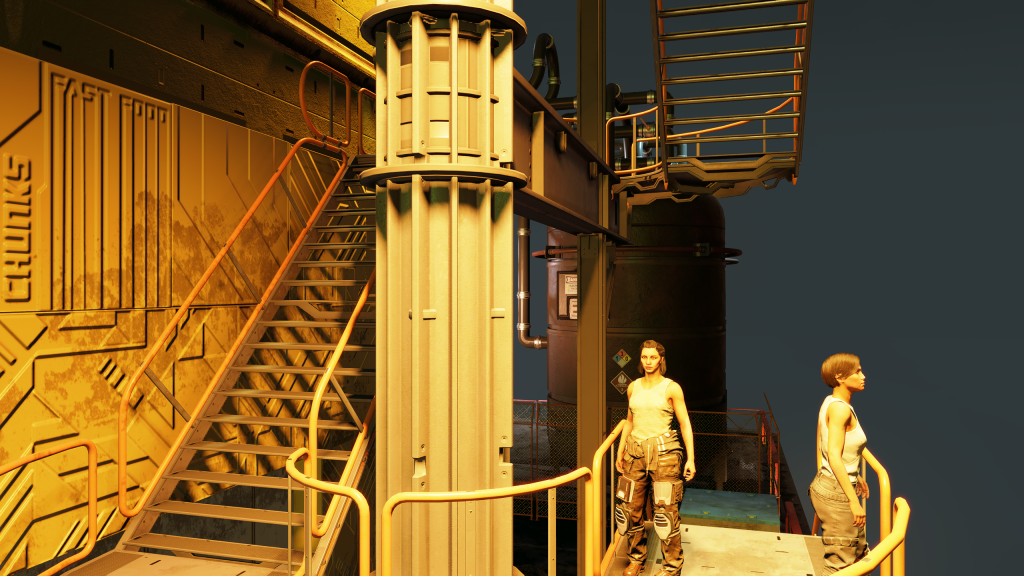







Perk magazines are few and far between, and you can encounter the same perk magazine multiple times, in exact same location (including the shelf number of a locker if so) within the same category outpost but in a different planet light years away. Sometimes they do improve a skill, but you won’t loose anything if you play the entire game without coming across any. Contraband smuggling is a joke – probably exists to make you feel special when you invest a large amount of creds in upgrading Shielded Cargo when nothing else seems interesting enough. What appears like a folded spacesuit case or a stimulant drug is somehow scanned by the law enforcers thousands of kms away to detect if you are carrying what you should not. Even bigger farce is another type of contraband which is just “stolen goods” or “heretic” writings on paper!
So much for inclusivity and tolerance of modern society that we want to ban the book (i.e. pamphlets)!
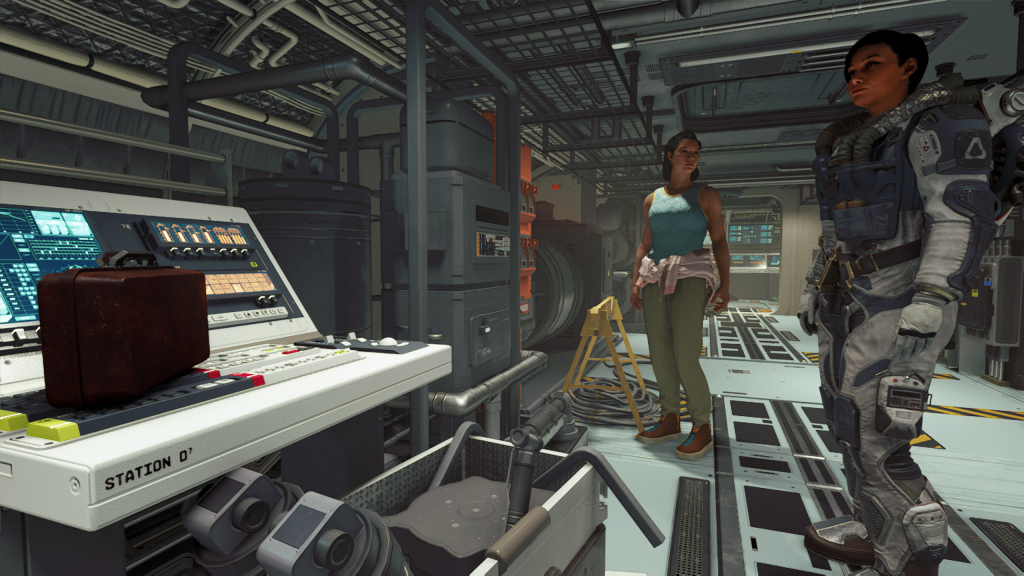
The engine is basically Fallout 4 with isolated maps connected through fast travel. Imagine 10x the map of Wasteland, so much distance between locations that one would just fast travel from one place to next (which one anyway does in Fallout too after “discovering” a location). Now distribute those locations in planets instead of a 50 sq. km area, and you get Starfield. The only place that makes you feel in space is during ship combat and salvaging parts from a broken ship (which is just a mouse click though – no stepping out of the ship and throwing a sling to pull over – that is too much for Bethesda).
It is hard to imagine that they did not hire QA to find these issues.
The most likely explanation is that all these issues caught during testing were purposefully shelved by the management. The fault does not lie with QA – it entirely lies with Todd Howard because it is his brainchild, and he cannot be unaware of what state the game was in at launch. Yet he decided to claim the half-hearted game as new IP just for money, riding on the goodwill that he earned from Skyrim and Fallout. I am certain that Todd played this game before release. At about 4 hours per day for 2-3 months, Todd as the game director must have had more than 300 hours in the game. Did it not occur to him that the game is just Fallout 4 in a new shell, including the visual fidelity? Was it not obvious that they should have done something unique in every area of the game that a player would spend most of their time? Or at least sort the performance since visual fidelity is not next generation?





The problem is not it being Fallout in space – the problem is that it is worse, while being falsely advertised as “new IP”.
No Man’s Land
Starfield does an extremely poor job of introducing the game lore. While Bethesda is never known for good lore/ narrative, it is even more apparent in a new IP since there is no old game in this IP to supplement it. What we get is at best is just a bunch of quests to Skyrim dragon stones remodeled as “temples”. You get certain powers there, just like dragon shouts. Then you use them in combat. And just like the dragon stones at the end of large dungeons in Skyrim, all the temples in Starfield are the same, with same animations when obtaining a power. Worse is that in Skyrim you would get a sense of exploration by “discovering” a stone at random, here you need to get the planet location from an NPC. If Todd went for quality over quantity, discovering temples (perhaps with added exploratory skills making it easier to identify the planets) could have been much rewarding.
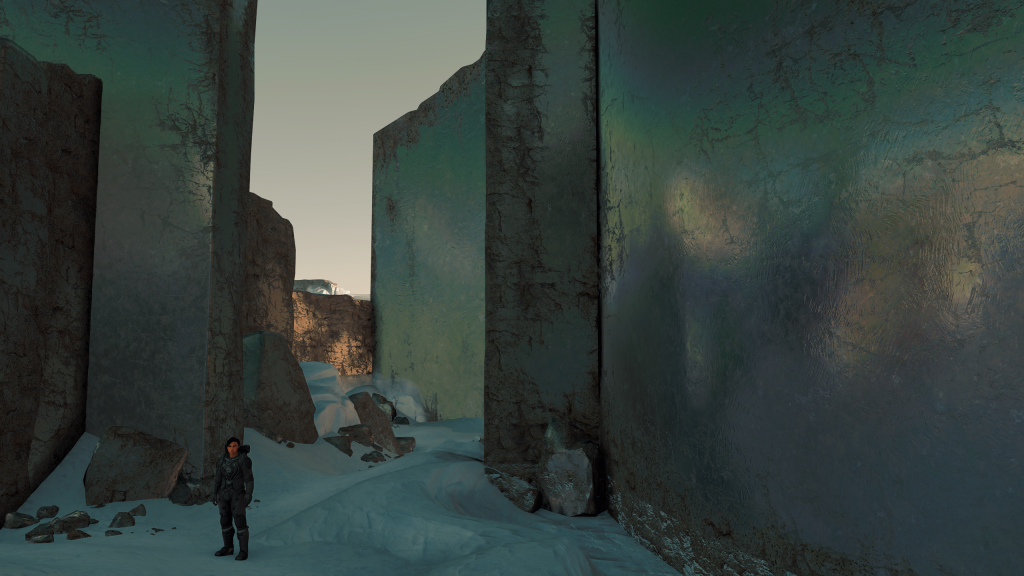
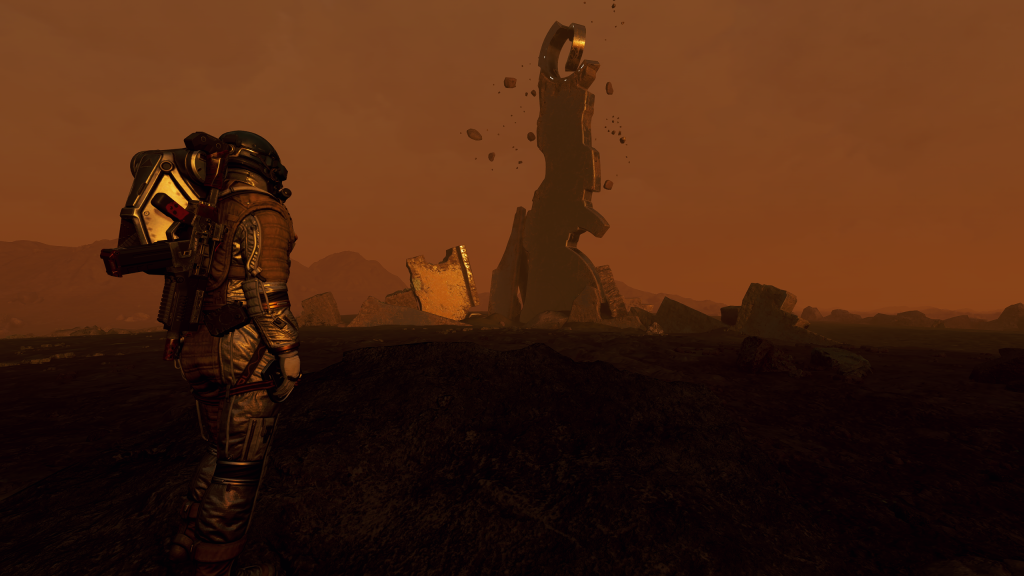

Another point in the never ending farce is RPG elements in the game. To be fair, Bethesda RPGs were never very intense in “role-playing” aspects. They were always much inferior to Divinity, Baldur’s Gate, Dragon Age, or Pathfinder games. In a way it is good, because it makes them more accessible to first time players, who then can ascend to more complex RPGs. Skyrim, with all its praise, is not a good “RPG” (hardcore RPG players rank Morrowind much higher). Its strength lied in exploration, item pickups, quests, and easy gameplay.
However, if this design suddenly wants to implore the players into doing chores like “achievements” using a skill after unlocking it, so that its next level can be unlocked, it removes the very freedom that was the USP of previous titles, and puts the role-playing on rail. For example, to unlock 2nd level in Ballistics skill, you need to kill 20 enemies with ballistic guns. Sounds good enough, but unlocking the 3rd skill now requires 50 kills, and the count is not cumulative. It impacts the very things that made Skyrim enjoyable. Hardcore RPG fans would anyway stay out of light Bethesda RPGs, putting Starfield in No Man’s Land (pun intended).
The player is given special powers – similar to dragon shouts from Skyrim. You go to a temple in a planet, solve a puzzle that becomes tedious second time onward (there are 20+ of them), and get a “power” exactly like how you would unlock a shout by staring at a Dragon Stone at the end of large dungeons in Skyrim. The animations when acquiring the power are derived from Skyrim so you will easily relate if you have played that game. Most disappointingly, the animations during use of the skill is lifted straight from those in Skyrim when the player uses the Thu’um. So if you warp gravity and throw it at some enemies, it feels exactly like you used a Dragon shout – same wind bursts and particle weaving.
Skills are similar to Fallout by design, with the only addition of some related to ship sailing and combat. It is comparable to power armor skills, so essentially a category is renamed. Though, the last row of skills in any category are pretty good, and worth pursuing for some time if one is not bored with the repetitive grind in the game.
You don’t actually get to “role-play” that much. The skill tree is flat; you don’t pursue a unique path to be somebody whom you cannot be by following another path, irrespective of the beginning traits – which really are about giving you one extra mission if at all, on locations you have already visited. For example, you can have a trait that you owe the bank lots of money. The game does not make your finances difficult to manage because of this. You can still do missions for the bank but if you don’t have that trait, there is no difference in the rewards. Another trait is “Wanted”, which simply spawns enemy spaceships at random if you are not quick enough to open the planet map after jumping to a system, but you can become Wanted even without this trait with just a couple of outpost infiltration that generate a bounty on you.

You can start by dumping points in physical abilities, then ship combat, then ballistics, then research, or any other order and you’ll still get to be the same character after enough levels. This is not the same as in Oblivion or Skyrim, because star signs would always give you some extra perk which here does not feel significant at all.
For example, you have a trait that gives more oxygen and damage dealt, but less recovery on consuming a potion (this is just a rethink of vampire or werewolf traits from Elder Scrolls). However, you get so many health packs scattered on the map that even on hard difficulty, it does not matter if you get 10% less recovery whether because of this trait or if you have caught some addiction. The latter is also easy to get by compared to Fallout, just as it is easy to get by over-encumbrance with a boost pack. For what it is worth, getting addicted just reduces carrying capacity, and only once. If you have a spacesuit or boost pack that adds carrying capacity, you can live with addiction, unlike in Fallout where rads would limit your health. While improving accessibility can be a design criteria, it does not make sense why even on hard difficulty the players cannot play this game like a RPG.




RPG is about choice. When I first started the game, I wanted to play a smuggler of contraband. The game does offer a questline that skirts the idea of being a smuggler, but the settled systems as a whole do not have enough smugglers to make it worthwhile. There is no network or incentive for you to steal contraband. Once you “loot” a contraband you can sell it at some specific locations without triggering the police scan as you enter the system, but those merchants are like any other, unlike fences – part of a network that had its own quest line like the Thieves Guild. They are just like a regular merchant whose credits reset after 48 hours. You are just making a trade, just that the item can be scanned red (that too with a probability if you have Shielded Cargo-hold in your ship) if you go into a faction controlled system.
This game does not meet the MVP requirements of an RPG video game.
A Wasteland in Space
WYSIWYG: What you “saw” is what you get
| Fallout/ Elder Scrolls | Starfield |
| Dragonborn | Starborn |
| Dragon Stone | Temple |
| Dragon Word/ Shout | Power |
| Deathclaw | Terrormorph |
| Stimpak | Medipack |
| Power Armor | Spacesuit + Pack (attributes)/ Spaceship (combat) |
| Blueprints | Research |
| Crafting/ Mods | Crafting/ Mods (with same goddamn menu) |
| Settlements | Outposts |
| Sanctuary | Lodge |
| Codsworth | Vasco |
| Fallout Shelters/ Vaults | The Well/ Cydonia/ Earth Colony Ship Constant |
| Children of Atom | Va-ruun |
| Diamond City | New Atlantis |
| Brotherhood of Steel | Freestar Collective |
| Institute | Constellation |
| Railroad/ Thieves Guild | Ryujin Industries |
| Minutemen | United Colonies Vanguard |
| Raiders/ Forged | Spacers/ Ecliptic |
| Gunners/ Triggermen | Crimson Fleet/ Bounty Hunters |
| Elder Scroll | Artifact |
| Windhelm | Akila City |
| Solitude/ Goodneighbor | Neon City |
| Adorable Fan | Adorable Fan (this one is actually well-done) |
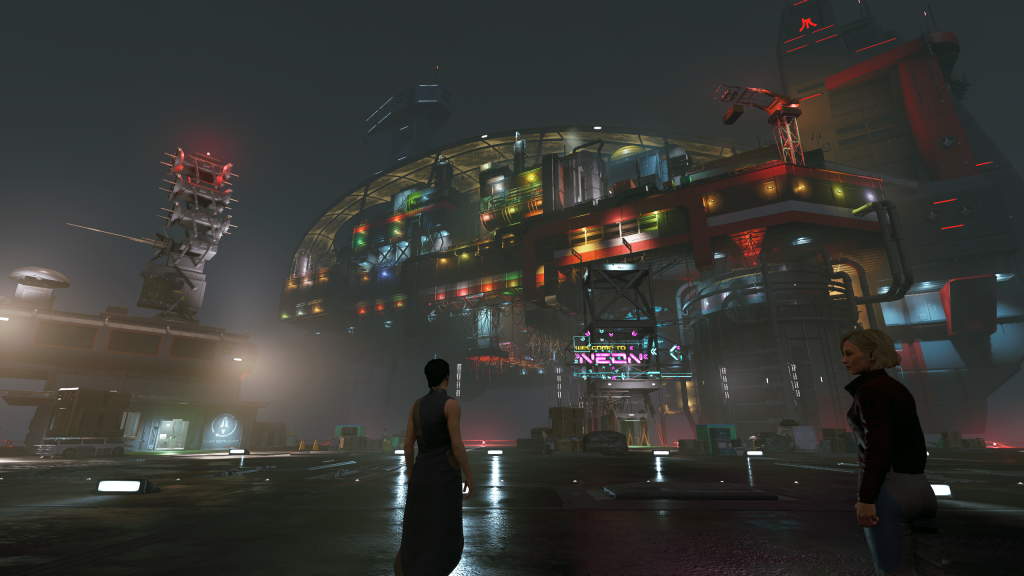

There is/ will be a mod for that [?]
Just like any other Bethesda title, Starfield will be made enjoyable only by modders, over time. What we have today, is just a platform for modders to deliver us the experience we want. 3 years from now, many of us will have 500+ hours in the game. Just not at this moment. This will not be a success of Bethesda, but the modders.
The ever-benevolent modding community is already at work again. Now they will spend countless hours fixing bugs and adding basic features like FOV, optimized textures, disabling color filters, etc. which should have been Minimum Viable Product for the team at Bethesda Game Studios. But with a $200M budget all we got was Fallout in Space, and were lied to that this was a new IP.
However, because Starfield is vastly inferior to Skyrim and Fallout, some modders seem to have lost the motivation to work on improving the game, because they being experts of Bethesda games, can sense (and correctly so) that most people will drop this game and move on, as is evident from Steam player charts.
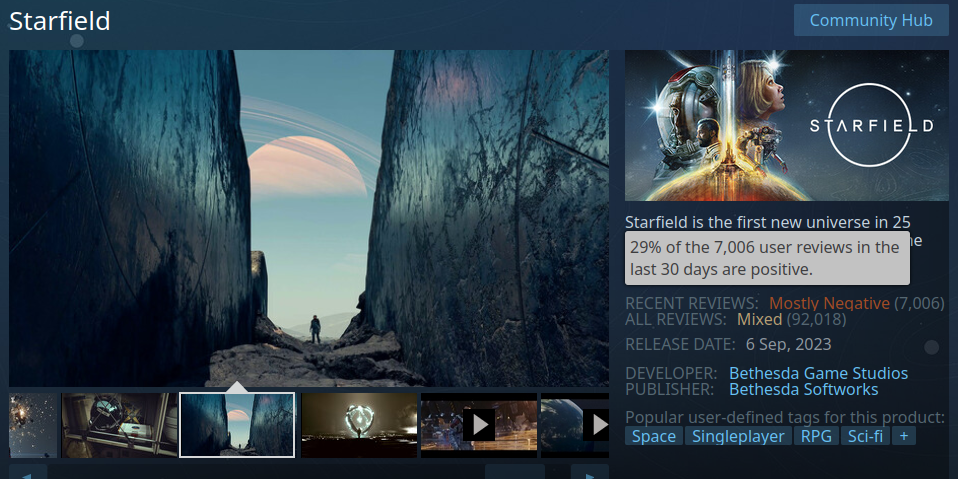
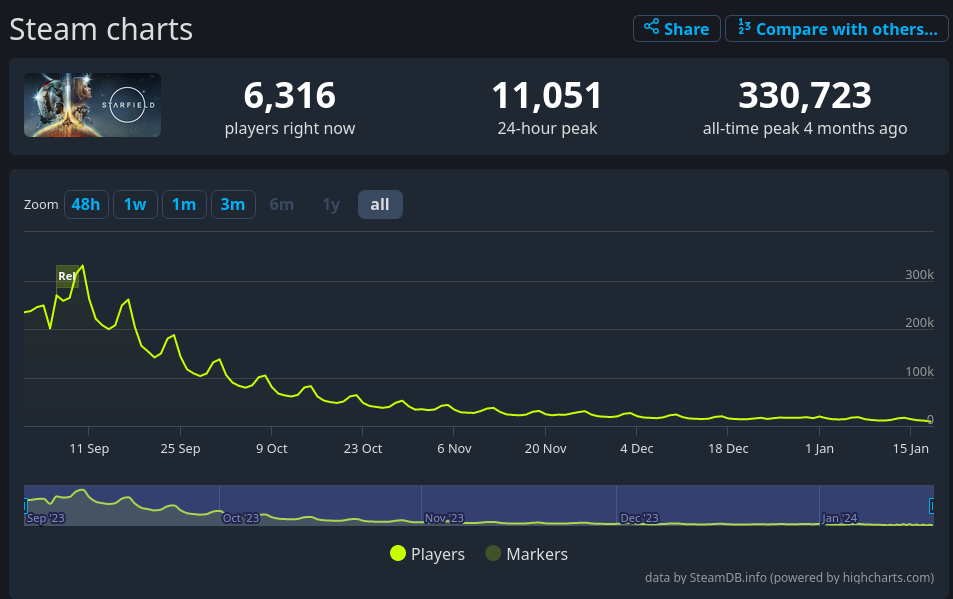
Modders who persevere and give us an enjoyable Starfield down the line, deserve a significant portion of that AAA price that Bethesda is asking. So it is wise to wait for deep discounts while playing other AAA titles of which there is no dearth of, even going by just 2023 launches. Then donate the savings from that discount, to the modders who have done the work that actually mattered.
Note that crediting the game as a platform for modders to create is like crediting DirectX or Vulkan API that we are able to play a video game.
New Game+ for Bethesda
Todd Howard really needs to give others a chance to lead Bethesda; free them of his myopic vision; now that they are a Microsoft company with no dearth of funds.
The game was already on 20% discount after less than two months of release, during Black Friday sale. And 30% during Winter Sale, a month later. While Microsoft made a big deal that about 6 million players were on the game at launch, they never disclosed how many of them actually bought the game and how many were simply trying it out on Gamepass. Sure the game being on Gamepass was a booster for latter’s subscriptions at least for the short term, but what about the game in isolation? Would Starfield have the same commercial success as Skyrim if there was no Gamepass? For that we need to look at Steam charts. And the results are red flag for Bethesda (and should be for Microsoft too – as Zenimax has failed to deliver yet again after Deathloop and Redfall). Starfield is currently at a lower rating than Fallout 76, Bethesda’s lowest point previously. So Todd Howard has achieved a new low with Starfield, literally.


If there was no Gamepass and only retail sales, Starfield could have been the least played game of Bethesda as well, not just lowest-rated.
A poorly designed game cannot be saved by Gamepass – it can produce a spike temporarily in number of players, but real metrics become evident in a month or two after launch. For perspective, Skyrim was still full price several years after launch, with discounts only starting to appear near the launch of Special edition 5 years later. Skyrim also sold physical copies, I remember seeing them always at full price even after Dragonborn DLC.
Intellectually bankrupt
*Todd Howard “is” the self-certified greatest video game director of all time. Otherwise he could not have dismissed the lack of optimizations (borderline unready for release) with a smug and shamelessly ask people to upgrade their PC instead.
16 times the detail
Lord Howard, 2018
New IP in 25 years
Lord Howard, 2023
Waiting for the next greatest quote of all time, surely involving 36 (next square in series, also square of next Elder Scrolls number).
In all seriousness though, after creating Morrowind, Oblivion, Skyrim, and Fallout 3/4, receiving so many accolades (rightfully so), in 2023 he “is” the most intellectually bankrupt game director out there. It was better for him to step aside after Fallout 76.










We might still keep hopes for the next Elder Scrolls because it is mostly going to be set in a different world (Summerset Isles/ High Rock/ Hammerfell) not seen yet in mainstream ES titles – offering new locations, characters, lifestyle, thus new play options (perhaps a mix of new D&D rules thrown at too). But I shudder at the thought of Fallout 5. Let us not have another Fallout game, especially with Todd Howard directing it. We have now seen all that can come out of his creativity in that space (pun intended).
A Mass Effect is out of syllabus for Bethesda, but a Dragon Age certainly is doable. So Bethesda can realize its dream of achieving next rank of parity with Bioware after all (they have already achieved the first rank of Anthem with Fallout 76, for those wondering).
Summary/ TLDR
Starfield is an intellectually bankrupt RPG with atrocious levels of PC performance falsely marketed as a “new IP in 25 years” that seems like a product spit out by ChatGPT and has any amount of player base only because Gamepass and some old Bethesda RPG fans like us (#3 in both likers and dislikers list above).
Perhaps the entire game is AI-generated, not just the developer responses to Steam reviews. So the joke is on us.
Pros:
- Excellent Gunplay and Combat, shooting guns feel good
- Better enemy AI than Fallout, though unresponsiveness at gunpoint is much more frequent
- Downscaling resolution still looks good. 60% scaling of 1080p does not look too worse than 1080p
- Easy gameplay loop, without any learning curve. Ideal for relaxing after a long day at work
- Between few and far legendary loot, the game looks gorgeous at times
Cons:
- Extremely poor performance for the visual fidelity. Unoptimized game that does not improve with lower graphics settings, runs at 30 fps even on strongest of consoles
- Decade+ old game engine with just better HD textures, no innovation, not even a land rover in a space exploration RPG
- Small shell of a game “procedurely” duplicated over and over to inflate as a large game
- False advertising – certainly not a new IP behind the scenes, just Fallout in space but worse
- Space is just a backdrop, purposefully kept to allow false advertising. Could have been America 1492 with ships instead of space ships, and old earth guns
- Very little, if at all, RPG dice roll. Grind is much worse than Skyrim or Fallout

Final Verdict: Don’t buy at full price. Wait for a Bethesda price.


